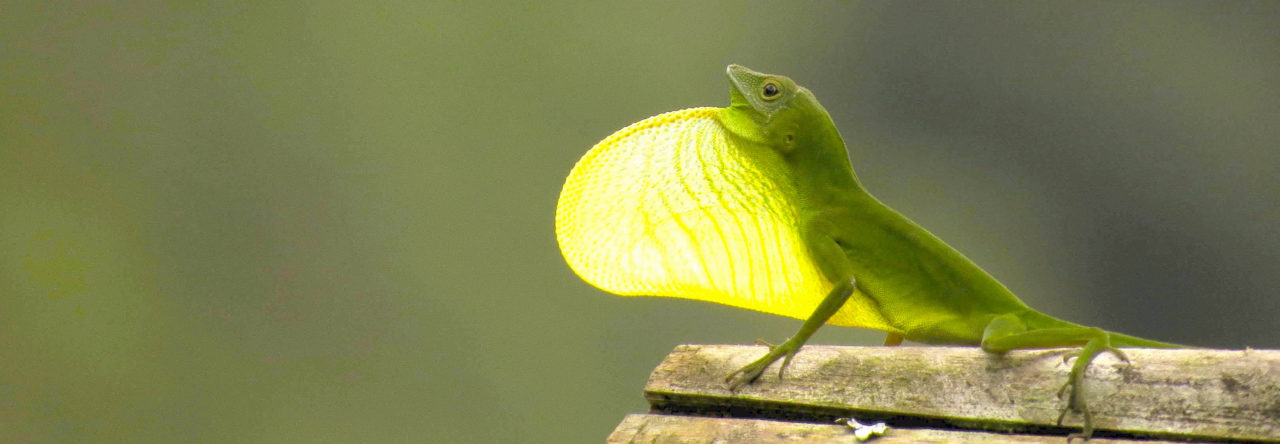 Understanding dispersal—the extent to which organisms move from their place of birth—is of obvious importance in understanding many aspects of the natural history of a species, such as how related individuals are in a population or how genetically distinct one population is from another. Despite the intensive study on Anolis, however, very little is known about their dispersal. This is particularly surprising for species like the green and brown anoles, which are so common in so many places. Now, in a very nice experimental study in Behavioral Ecology, Calsbeek and colleagues have shed light on dispersal in the brown anole in the Bahamas.
Understanding dispersal—the extent to which organisms move from their place of birth—is of obvious importance in understanding many aspects of the natural history of a species, such as how related individuals are in a population or how genetically distinct one population is from another. Despite the intensive study on Anolis, however, very little is known about their dispersal. This is particularly surprising for species like the green and brown anoles, which are so common in so many places. Now, in a very nice experimental study in Behavioral Ecology, Calsbeek and colleagues have shed light on dispersal in the brown anole in the Bahamas.
Basically, the study went like this: the authors collected a bunch of gravid females from a variety of sites on a single, small island in the Bahamas. They got the lizards to lay eggs in the lab and hatched them out, then released them within three weeks of hatching back on their mom’s island. Each lizard was individually marked. The researchers then returned the following spring to find which animals had survived and how far they had moved. Then, they returned again in the fall to see how these survivors fared over the following summer and whether subsequent survival in this second period varied as a function of the distance they had dispersed in the first period.
There are a lot of interesting specific details and I encourage you to read the paper, but the broader story is this:
1. Males dispersed substantially further than females
2. Surviving males grew faster than surviving females
3. Survival of the lizards was low
4. Among females that survived the first period, those that had dispersed shorter distances survived better in the second period
Surprisingly little is known about the extent of anole dispersal, and so this paper is an important advance. As far as I’m aware, dispersal of only two other anoles have been studied. Here’s a summary from Lizards in an Evolutionary Tree:
“Little is known about the dispersal of anoles. One study of A. limifrons found that most lizards dispersed very little and that the home ranges of many individuals moved little from the juvenile to adult age. The maximum dispersal distance, measured as distance from the center of the juvenile home range to the center of the adult home range, based on 148 individuals, was 45 meters. Both the mean and extremes were greater for males than for females (Andrews and Rand, 1983). Anolis limifrons is a small and short-lived mainland species; it is always possible that larger, longer-lived species may disperse further.
The only other data come from Anolis aeneus, which moves as much as 150 meters or more after hatching to occupy open clearings (Stamps, 1983b, 1990). Ultimately, the lizards move back into shadier areas when they reach subadult size, although it is not known whether they return to the vicinity of their hatching site.
A number of arboreal species are known to disperse across open ground between trees (Trivers, 1976; Hicks and Trivers, 1983; Losos and Spiller, 2005).
- Evolution in Real Time on Lizard Island - March 23, 2025
- Spider Snags Adult Anolis osa - March 22, 2025
- An Homage to the Green Anoles of New Orleans - March 21, 2025


David Delaney
I’ve noticed similar age-class habitat selection in A. sagrei as that described by Stamps (1983) in A. aeneus. At our study site (northeast Florida), it seems hatchlings disperse into open canopy habitats where they spend their adolescence. Then as adults they take up the trunk- ground ecomorph habitat selection and are most frequently encountered in forested habitats.
Robert Heathcote
Does anyone have any thoughts on whether these dispersal sex differences are driven by male territorial behaviour (i.e. juvenile males are having to disperse further because suitable territories are occupied by adult males), or whether they’re independent of the social environment?